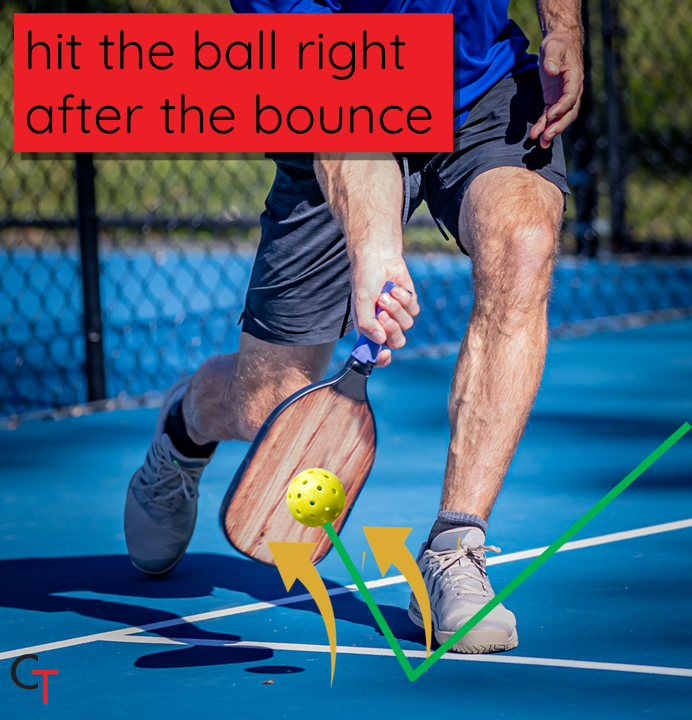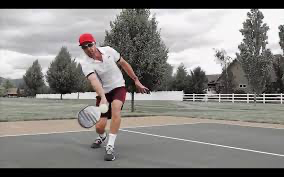What’s a shot that is necessary to have but you don’t want to utilize it all the time? It can take time away from your opponent and allow you to advance to the non-volley zone?
It’s the kind of shot that you have to do less work for the faster the opponent hits at you? I’m talking about the short hop - or commonly known as the half-volley.
This is a shot that is taken as soon as the ball has bounced on the ground, not allowing it to rise up to its apex. This is more of a defensive shot, rather than offensive but is key to have in your toolbelt.
The reason I feel this shot is necessary is that your timing to get to the ball can often be misjudged - the half-volley can allow you to still maintain a certain level of control of the ball to the point of creating a dink or reset shot, in a scenario where you are at the disadvantage.
I personally have utilised this shot after using it in my (short-lived) club tennis “career”, the “bunny hop” if you will, but I’ve also gotten into the habit of using it at the kitchen, in dink rallies, and in that case, the short hop is not an ideal choice.

Photo credit: Sara McInnes
When to Use This Shot
An obvious example of when to use this shot is during a return of serve. Imagine a deep, hard serve that you’ve moved up too soon and quickly to receive.
Rather than the ball getting behind the body, there has to be an adjustment of the paddle so that the contact point happens immediately after the bounce. That said, this shot can technically be utilized all over the court.
Anytime where you have to meet that ball closer into the body, or are unable to use good footwork to get yourself into a solid contact point - this would simply mean that your timing is slightly off and you can’t hit the ball in a comfortable zone.
There are so many players who come from racquet sports who are not used to the ball bounces, so the mistiming occurs pretty frequently.

Photo credit: Sara McInnes
What You Need to Do
A lot of pickleball is about absorbing the impact of the ball and some people tend to lean backward thinking that’s the best way to absorb the momentum, however, you actually want to lean into the shot you’re receiving and the same goes for the short hop.
Stay lower to the ground because you’re meeting the ball off the initial bounce; stay grounded and in a steady, athletic stance.
As you’re getting used to the shot it’s going to be important to really keep your eyes on the ball and track it the whole way through.
Your grip on the paddle should be semi-firm, or firm, but not too loose. The harder you hold this grip or the harder the shot, the faster that ball will short-hop off your paddle.
Finally, be sure to not move forward too quickly in your follow-through, the short hop may not be a reset into the non-volley zone, so there’s a chance the opponent will be able to volley your shot.
That said, the half-volley can cause some trouble for you and you may get into a defensive trap with this shot.
If you can’t get the ball to descend as it’s crossing the net your short hop will result in the other team volleying and most likely applying more pressure on your team, and likely forcing you to hit a few half volleys in a row.
If you do recognize that your ball is going to drop into the kitchen, that’s your chance to advance a few steps and reduce the amount of court the opponent has to work with.
How to Practice This Shot
This is best practiced in a two person format on one half of the court. One person is standing at the net, they are the feeder, and are hitting balls towards the other person's feet at the back of the court.
The person practicing this shot is going to focus on taking the ball off the bounce - if it’s possible to take it as a volley, wait for that bounce first before making the move.
As you get a feel for the timing, begin to focus on eliminating the backswing in the movement, just use the original momentum of the shot for the short hop. It may feel like you need to give more to the shot but you really don’t.
As you get more comfortable practicing this scenario, you can then move to practice the half-volley from the baseline; the feeder will serve the ball and you can practice the shot as a return of serve half-volley.
The feeder should focus on faster, deep serves while you will focus on moving into the ball early.
With any drill, it’s important to focus on the skill specifically, so as tempting as it will be to play out the rest of the rally, that could also cause some distraction to the main point of the drill. Instead of playing out full rallies, get into the rhythm of just practicing the actual shot or scenario, and hone in on the repetition.
The way you can physically see success in your short hops is that the ball will go from high to lower as it crosses the net and the pace of the shot will vary (some people can hit a fairly fast-paced shot, almost similar to a forehand drive versus a drop shot).
The more comfortable you become with the shot you will be able to quickly gauge the grip pressure on the handle and start to manipulate the ball into short hop drops and hit different angles of the court.
Until then, maintain the focus on no or low unforced errors are you this shot and gain consistency. As mentioned, it’s a shot that you don’t want to hit too often, so understanding when and where to use the half-volley will take some time.
This article was taken from our 'Control the Kitchen' Newsletter, if you're interested in receiving more content like this, please feel free to sign up using the subscribe section located at the bottom left of this page (or underneath the article if you're on mobile), thanks!